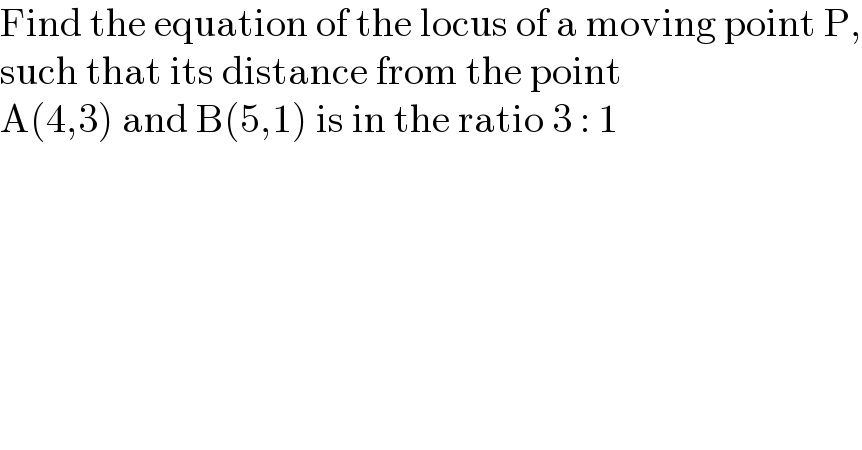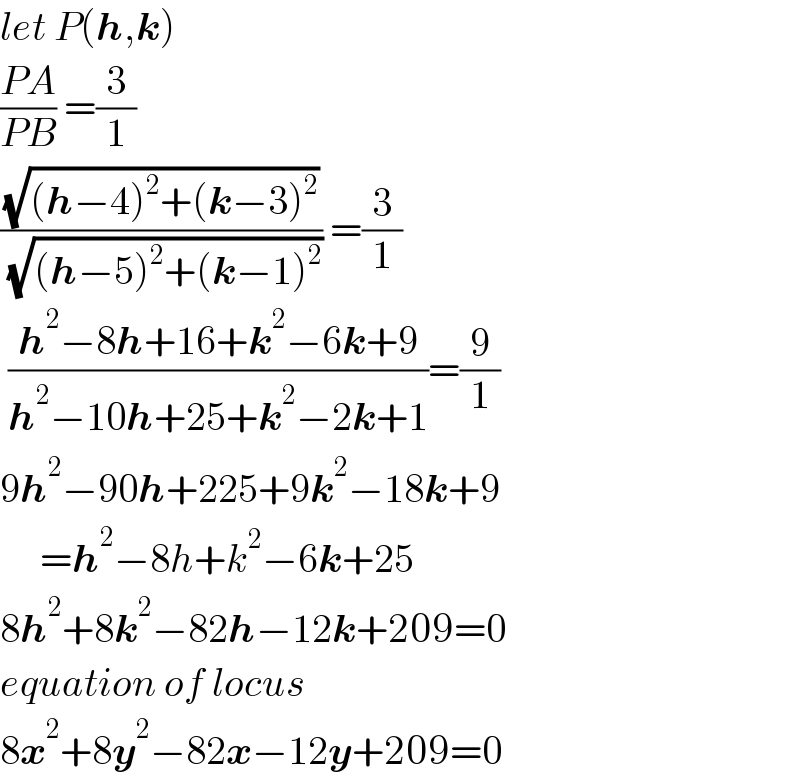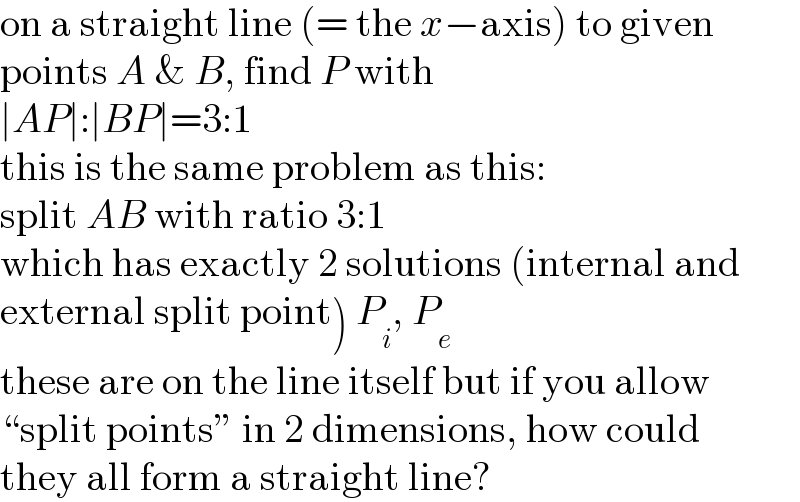
Question Number 167185 by pete last updated on 09/Mar/22

$$\mathrm{Find}\:\mathrm{the}\:\mathrm{equation}\:\mathrm{of}\:\mathrm{the}\:\mathrm{locus}\:\mathrm{of}\:\mathrm{a}\:\mathrm{moving}\:\mathrm{point}\:\mathrm{P}, \\ $$$$\mathrm{such}\:\mathrm{that}\:\mathrm{its}\:\mathrm{distance}\:\mathrm{from}\:\mathrm{the}\:\mathrm{point} \\ $$$$\mathrm{A}\left(\mathrm{4},\mathrm{3}\right)\:\mathrm{and}\:\mathrm{B}\left(\mathrm{5},\mathrm{1}\right)\:\mathrm{is}\:\mathrm{in}\:\mathrm{the}\:\mathrm{ratio}\:\mathrm{3}\::\:\mathrm{1} \\ $$
Commented by mr W last updated on 09/Mar/22

$${the}\:{locus}\:{of}\:{a}\:{moving}\:{point},\:{whose} \\ $$$${distances}\:{to}\:{two}\:{fixed}\:{points}\:{are}\:{in} \\ $$$${a}\:{constant}\:{ratio},\:{is}\:{a}\:{circle}. \\ $$
Commented by otchereabdullai@gmail.com last updated on 21/Mar/22

$$\mathrm{Nice}! \\ $$
Answered by Rasheed.Sindhi last updated on 09/Mar/22

$$\mathrm{P}=\left({x},{y}\right) \\ $$$$\mid\mathrm{AP}\mid:\mid\mathrm{BP}\mid=\mathrm{3}:\mathrm{1} \\ $$$$\mid\mathrm{AP}\mid=\mathrm{3}\mid\mathrm{BP}\mid \\ $$$$\sqrt{\left(\mathrm{4}−{x}\right)^{\mathrm{2}} +\left(\mathrm{3}−{y}\right)^{\mathrm{2}} }=\mathrm{3}\sqrt{\left(\mathrm{5}−{x}\right)^{\mathrm{2}} +\left(\mathrm{1}−{y}\right)^{\mathrm{2}} }\: \\ $$$${x}^{\mathrm{2}} −\mathrm{8}{x}+\mathrm{16}+{y}^{\mathrm{2}} −\mathrm{6}{y}+\mathrm{9}=\mathrm{9}\left({x}^{\mathrm{2}} −\mathrm{10}{x}+\mathrm{25}+{y}^{\mathrm{2}} −\mathrm{2}{y}+\mathrm{1}\right) \\ $$$$\mathrm{8}{x}^{\mathrm{2}} +\mathrm{8}{y}^{\mathrm{2}} −\mathrm{82}{x}−\mathrm{12}{y}+\mathrm{209}=\mathrm{0} \\ $$
Answered by som(math1967) last updated on 09/Mar/22

$${let}\:{P}\left(\boldsymbol{{h}},\boldsymbol{{k}}\right) \\ $$$$\frac{{PA}}{{PB}}\:=\frac{\mathrm{3}}{\mathrm{1}} \\ $$$$\frac{\sqrt{\left(\boldsymbol{{h}}−\mathrm{4}\right)^{\mathrm{2}} +\left(\boldsymbol{{k}}−\mathrm{3}\right)^{\mathrm{2}} }}{\:\sqrt{\left(\boldsymbol{{h}}−\mathrm{5}\right)^{\mathrm{2}} +\left(\boldsymbol{{k}}−\mathrm{1}\right)^{\mathrm{2}} }}\:=\frac{\mathrm{3}}{\mathrm{1}} \\ $$$$\:\frac{\boldsymbol{{h}}^{\mathrm{2}} −\mathrm{8}\boldsymbol{{h}}+\mathrm{16}+\boldsymbol{{k}}^{\mathrm{2}} −\mathrm{6}\boldsymbol{{k}}+\mathrm{9}}{\boldsymbol{{h}}^{\mathrm{2}} −\mathrm{10}\boldsymbol{{h}}+\mathrm{25}+\boldsymbol{{k}}^{\mathrm{2}} −\mathrm{2}\boldsymbol{{k}}+\mathrm{1}}=\frac{\mathrm{9}}{\mathrm{1}} \\ $$$$\mathrm{9}\boldsymbol{{h}}^{\mathrm{2}} −\mathrm{90}\boldsymbol{{h}}+\mathrm{225}+\mathrm{9}\boldsymbol{{k}}^{\mathrm{2}} −\mathrm{18}\boldsymbol{{k}}+\mathrm{9} \\ $$$$\:\:\:\:\:=\boldsymbol{{h}}^{\mathrm{2}} −\mathrm{8}{h}+{k}^{\mathrm{2}} −\mathrm{6}\boldsymbol{{k}}+\mathrm{25} \\ $$$$\mathrm{8}\boldsymbol{{h}}^{\mathrm{2}} +\mathrm{8}\boldsymbol{{k}}^{\mathrm{2}} −\mathrm{82}\boldsymbol{{h}}−\mathrm{12}\boldsymbol{{k}}+\mathrm{209}=\mathrm{0} \\ $$$${equation}\:{of}\:{locus} \\ $$$$\mathrm{8}\boldsymbol{{x}}^{\mathrm{2}} +\mathrm{8}\boldsymbol{{y}}^{\mathrm{2}} −\mathrm{82}\boldsymbol{{x}}−\mathrm{12}\boldsymbol{{y}}+\mathrm{209}=\mathrm{0} \\ $$
Commented by pete last updated on 09/Mar/22

$$\mathrm{Thank}\:\mathrm{you}\:\mathrm{very}\:\mathrm{much}\:\mathrm{sir}.\:\mathrm{But}\:\mathrm{sir},\:\mathrm{why}\:\mathrm{is}\:\mathrm{the}\:\mathrm{locus} \\ $$$$\mathrm{of}\:\mathrm{the}\:\mathrm{point}\:\mathrm{not}\:\mathrm{a}\:\mathrm{straight}\:\mathrm{line}\:\mathrm{but}\:\mathrm{a}\:\mathrm{circle}? \\ $$$$\mathrm{That}\:\mathrm{is}\:\mathrm{my}\:\mathrm{problem}. \\ $$
Commented by som(math1967) last updated on 09/Mar/22

$${A}\:{and}\:{B}\:{is}\:{fixed}\:{pt}\:{but}\:{P}\:{is}\:{movable}\:{pt} \\ $$$${such}\:{PA}:{PB}=\mathrm{3}:\mathrm{1}\:{so}\:{path}\:{of}\:{P}\:{is}\:{not} \\ $$$${st}.\:{line}\: \\ $$
Commented by MJS_new last updated on 09/Mar/22

$$\mathrm{on}\:\mathrm{a}\:\mathrm{straight}\:\mathrm{line}\:\left(=\:\mathrm{the}\:{x}−\mathrm{axis}\right)\:\mathrm{to}\:\mathrm{given} \\ $$$$\mathrm{points}\:{A}\:\&\:{B},\:\mathrm{find}\:{P}\:\mathrm{with} \\ $$$$\mid{AP}\mid:\mid{BP}\mid=\mathrm{3}:\mathrm{1} \\ $$$$\mathrm{this}\:\mathrm{is}\:\mathrm{the}\:\mathrm{same}\:\mathrm{problem}\:\mathrm{as}\:\mathrm{this}: \\ $$$$\mathrm{split}\:{AB}\:\mathrm{with}\:\mathrm{ratio}\:\mathrm{3}:\mathrm{1} \\ $$$$\mathrm{which}\:\mathrm{has}\:\mathrm{exactly}\:\mathrm{2}\:\mathrm{solutions}\:\left(\mathrm{internal}\:\mathrm{and}\right. \\ $$$$\left.\mathrm{external}\:\mathrm{split}\:\mathrm{point}\right)\:{P}_{{i}} ,\:{P}_{{e}} \\ $$$$\mathrm{these}\:\mathrm{are}\:\mathrm{on}\:\mathrm{the}\:\mathrm{line}\:\mathrm{itself}\:\mathrm{but}\:\mathrm{if}\:\mathrm{you}\:\mathrm{allow} \\ $$$$``\mathrm{split}\:\mathrm{points}''\:\mathrm{in}\:\mathrm{2}\:\mathrm{dimensions},\:\mathrm{how}\:\mathrm{could} \\ $$$$\mathrm{they}\:\mathrm{all}\:\mathrm{form}\:\mathrm{a}\:\mathrm{straight}\:\mathrm{line}? \\ $$
